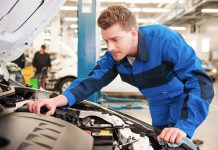
by Tracey Schelmetic
With the COVID-19 pandemic and the closure or operating restrictions of many auto manufacturing facilities, the number of news cars available has temporarily declined, leaving many dealers to recoup their fortunes with preowned vehicles. Rising prices, as well as a rising customer expectations, have made the process of intensive vehicle reconditioning more critical than ever as used vehicles are playing a bigger role in keeping inventories balanced. Properly reconditioned vehicles can be sold for thousands more than other used vehicles, yet many dealers don’t take the time to engage in a first-class reconditioning process to ensure their used inventory is in top-notch condition.
Successful used vehicle dealers understand that reconditioning is an investment. It’s important, however, to rein in costs as well as the time it takes to turn the vehicle around, or the return on investment can be poor. Given the range of procedures that might be involved in reconditioning, costs can escalate rapidly if they’re not effectively managed.
During a recent podcast, Dealer News Today spoke with Mike Boyd, founder of iRecon. Now Senior Director of Business Enablement for iRecon, a Cox Automotive Company, Boyd is an expert in the vehicle reconditioning process, and noted that dealers need a better understanding of where they will get the most value out of selling a used vehicle.
“To do this, they need to ensure that all parties – sales, service and consumers – are on the same platform,” he said. “Particularly now, when cars have been sitting on lots for a long time, great reconditioning is vital to please customers and increase retention.”
A Need for Speed
Making the used vehicle conditioning process easier is key to keep sales flowing and inventory turning over rapidly.
“Once you own the vehicles, speed is of the essence to make the most of every investment,” according to a Cox Automotive Report. “Ideally, you want to retail at least 55 percent of your inventory in under 30 days of age to ensure sufficient sales velocity and profitability, given today’s era of price competition and margin compression.”
This puts the onus on dealers to prepare used vehicles very quickly. When these processes are done in an informal way, it can lead to delays, mistakes and missed opportunities. A reconditioning management platform such as iRecon automates the process so everything is done in a timely way and nothing is missed.
“Dealers are heavily looking at internals,” noted Boyd. “If you’re not selling more cars because something’s going on, you have to find different avenues. One of the best ways to make an immediate difference is to look at your internal costs [for reconditioning]. What are you doing? Why are you doing it? Are you doing it as efficiently as you could? Do we have the right people in the right places, not only for right now, but coming out of [the COVID pandemic]?”
When a dealer can turn reconditioning of a vehicle around quickly, they can improve their speed-to-market, make the sale, go back to the market and acquire new resources, which makes getting cars frontline-ready more important than ever.
“Get cash,” noted Dave Cantin in the podcast. “Because cash is key – and turn it around. It’s like sharpshooting.”
Reconditioning is Vital to the Customer Experience
Customers may be stuck at home, but they haven’t stopped shopping for vehicles. They’re just looking for different experiences when they shop for vehicles. Their touchpoints are becoming more digital and more virtual, and dealers need to ensure their processes are aligned with what customers want. This becomes especially challenging when many dealers are finding vehicles coming through the system that are a bit different from what they would normally carry.
“We’ve seen that before, in a downturn, where dealers start thinking outside their own back yard,” said Cantin. “I’m seeing more activity where they’re spending more, but more precisely, because they’re focusing on the right cars. Take advantage of the downtime to review processes and hone them to be better prepared to meet market needs.”
While dealers may not be able to control the economy or the pandemic, they can control how they match their sales and reconditioning approach to what buyers want today.
“It’s about creating a customer experience throughout the sales process and the reconditioning process that connects everyone together,” said Cantin. “The experience is what’s remembered when purchasing a new or used car.”
A Formal Process for Reconditioning
Boyd noted that, on average, dealers put about $1,200 into reconditioning a vehicle, with some variance between brands. These are costs for engine maintenance, detailing, touchup, service, and dent repair. If dealers can improve the efficiency of the process, they could see a rise in their profits. iRecon is the only platform that connects vendors, dealers, and consumers to automate and optimize the process of reconditioning a used car.
It does this, in part, by identifying all the players involved in the reconditioning process: everyone from the salespeople, to the service department to the shoppers themselves.
“We took the approach of the people doing the work,” said Boyd. “What do they need? They need clear lines of communication. They need to know what needs done. We do a horrible job usually of clearly defining what our expectations are. So bringing the service providers in with the managers, to the sales people, to the consumer, and everybody can see what’s going on.”
In addition to automating the sales and service procedures, consumers can use the app to find the vehicles they want on lots. Sales personnel can use it to show the consumer specifically what’s been done to make a vehicle a certified car. Service departments can use it to streamline their processes and get everything completed in a timely manner.
“Smooth out the auto provisioning process and eliminate the peaks and valleys that can interfere with sales,” said Boyd.












